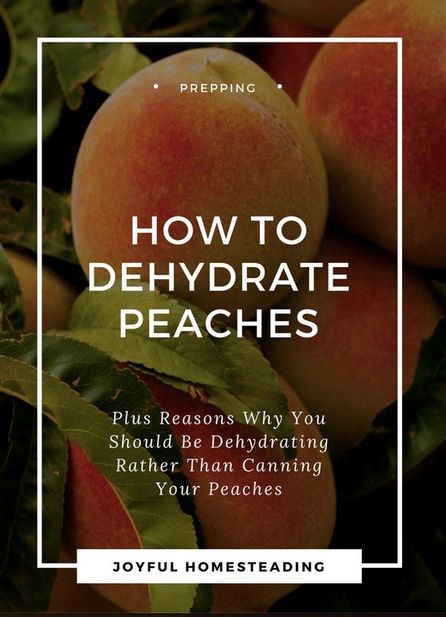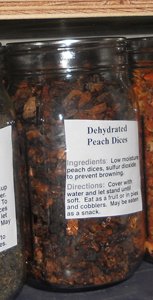Dehydrating Peaches
Dehydrating peaches is one of the easiest ways to store a bounteous harvest. Learn to dehydrate peaches, and you will have a nutritional fruit that makes an excellent long-term storage food.

Excellent Stored Nutrition
When most people think of ways to store their homegrown peaches, canning typically comes to mind. But choosing to dehydrate those peaches instead of canning them have many benefits including the following:
- Easier to Prepare - Canning peaches is a skill that must be learned and done carefully. Otherwise, the end result could be disastrous - botulism! But dehydrating peaches is much easier, especially if you are new to storing a bounty of peaches.

- Easier to Store - Because the water is removed from dehydrated fruits, the end result is lighter and takes up far less space.
- Lasts Longer - Can your bounty of peaches, and you will have to use them up within a year. Freeze those same peaches, and you have even less time - about six months, unless you vacuum seal them (then they'll last about two years). But dehydrated peaches, properly stored, can last for years, even decades.
- Denser Nutrition - Dehydrating peaches will take some of the nutrients out, but ounce for ounce, you will be getting far more nutrients and fiber than you would from the canned or even fresh variety. Because dried fruits have more fiber, they will improve your digestion and help you feel less hungry, a benefit if you are trying to lose weight.
Dehydrating Peaches - Getting Started
Choose the best possible peaches to dehydrate - no soft spots, worm holes or bruises. You can either leave the skins on or remove them. If you choose the leave the skins on, scrub your peaches to remove the fuzz (and pesticides if you bought your peaches as opposed to growing them yourself).
Like other fruits, peaches will turn brown once they have been cut and exposed to oxygen, so you will need to soak your peaches in either lemon juice, sodium bisulfite or other acidic fruit preserver.
While the dried fruit will taste just as good without lemon juice or other acidic preserver, brown-looking dried fruit isn't as visually appealing. Also, it will be harder to get your children to eat brown dried fruit. So add either lemon juice or other acidic preserver.
Preparing Your Fruit
Cut the peach all the way around. Then twist the peach, and it should separate in two sections. Cut and twist each half, and the pit should free more easily from the flesh. Slice your peaches and drop them in your acidic solution.
Once you have finished preparing all your fruit, drain your slices and place them close together, but not touching on your dehydrator trays. Don't stack the slices on top of each other, or your fruit won't dry properly.
Let your dehydrator run anywhere from six to twenty four hours or until the peach slices are pliable. Rotate the trays periodically for even drying.
Storing Dried Fruit
Oxygen will age and spoil your fruit, so once you have finished dehydrating peaches, store the slices in a quart-sized jar and either vacuum seal the jar or add an oxygen absorber and seal the lid on tightly.
Store the jars in a cool, dark place.
Properly stored, dehydrated peaches could last ten years or longer.

A Word of Caution
If mold starts growing on your dried foods, throw the whole package out.
Related article: Finding the right dehydrator for you.
Learn More About Frugal Cooking







New! Comments
Have your say about what you just read! Leave me a comment in the box below.